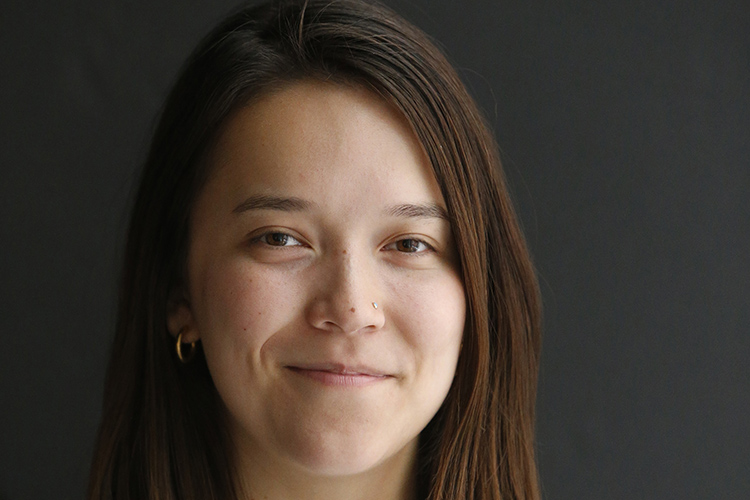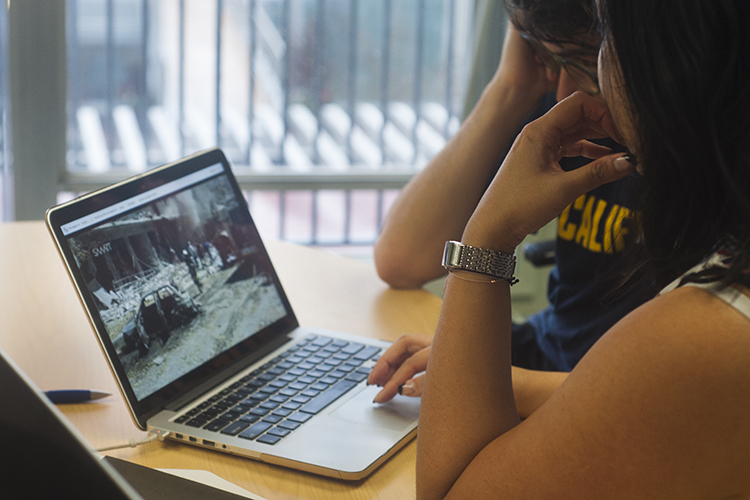Alumna’s skills assist New York Times’ alarming George Floyd video
Haley Willis, a 2019 grad, has joined the Times' visual investigations team

June 4, 2020

Haley Willis, a 2019 UC Berkeley graduate with degrees in sociology and media studies, is now a visual investigations reporter and video producer at the New York Times. She was trained in open source research as a member of the campus’s Human Rights Investigations Lab. (Photo by Earl Wilson)
On May 31, the New York Times published “8 Minutes and 46 Seconds: How George Floyd was Killed in Police Custody,” a reconstruction of the May 25 death in Minneapolis of Floyd, a 46-year-old black man. This example of explanatory visual journalism, a type of storytelling, gets at the truth through bystanders’ videos, security camera footage, audio from scanners and official documents.
Haley Willis, a 2019 UC Berkeley graduate, is a member of the Times’ visual investigations team. She first learned open source investigation skills at Berkeley’s pioneering Human Rights Investigations Lab. There, about 100 students a year from 20-plus majors painstakingly collect and analyze open source, or public, digital information to help answer compelling human rights questions for the lab’s partners worldwide, including Amnesty International, Reuters news agency and the Syrian Archive.
Willis joined the Times as its sole visual investigations fellow a year ago and is now a full-time visual investigations reporter and video producer. Berkeley News caught up with Willis to ask about the Floyd project, life in New York during COVID-19 and the protests over Floyd’s death and how Berkeley readied her for her new career.
Berkeley News: Congratulations on your new job! When did it start?
The Times’ inaugural fellowship program — there were 23 fellows in total— lasts a year, and it actually ended just last week, on May 29. But I was hired full-time in December, so I was officially only under the title of fellow for about six months. I had no idea the offer was coming, so, it was a definite shock, one that I probably still haven’t recovered from. I’m so incredibly humbled and grateful to work with such brilliant people every day.
The work I’m proudest of, during my first six months, was on the Hong Kong protests, from the first day they began to the first shot fired on a protester. Engaging with people in Hong Kong to tell their stories, and taking in their reactions as we continued to cover the protests, was an experience that really shaped my time as a fellow.
How did the team’s “8 Minutes and 46 Seconds” video come together, and what was your role?
For us, what happened to George Floyd was a really important story to tell. We immediately took notice of the outrage sparked by his killing, and the fact that it had been captured on video. Any time a story is contested — in this case, debates about the actions of the officers — we want to take a closer look.
I worked on various parts of the project. I spoke to eyewitnesses and people directly involved at the scene, analyzed footage as more continued to be released and listened to hours of scanner audio that helped reveal what was going on behind the scenes with law enforcement and emergency medical services (EMS). This project took a village, and almost every single person on the team pitched in on every part of the reporting. It was amazing to see. You could tell it was a story that everyone really cared about.
We collected the material in various ways — some of it had been published publicly on social media, some released by the police. My colleague received the security cam footage from the owner of the (Dragon Wok) restaurant. And as we spoke to more eyewitnesses and others involved, we continued to try to source more footage that could help us understand what happened.
What stands out about what happened to Floyd is the series of actions the officers took that turned fatal, and how they kept piling up once we dug more into the story. (Ex-police officer Derek) Chauvin uses the knee hold on Floyd’s neck, and we found out that, per MPD (Minneapolis Police Department) rules, you can only do that when someone is actively resisting. Then, we got video from another angle and realized two other officers were also on top of Floyd, making the pressure and positioning even more dangerous, according to medical experts. Then, we found out through scanner audio that the police were requested by dispatch to inform the fire department of where to meet the ambulance with Floyd, but MFD (Minneapolis Fire Department) says it received no clear information from the officers. And that list continues, unfortunately.

In Manhattan, demonstrators, many wearing masks during the COVID-19 pandemic, take a knee before a moment of silence observed on June 3, 2020. They took to the streets to protest the May 25 killing of George Floyd, a black man who died in Minneapolis after a white police officer knelt on Floyd’s neck for nearly nine minutes. (AP photo by John Minchillo)
What was the Times’ goal, in recreating Floyd’s death via video, and in this format, for the public?
The purpose was not only to tell the full story, but to provide the analysis behind that story. A lot of people have seen video of Floyd pinned down, but they may not know that the other two officers were on top of him, as well. Or, they may not know the conversations happening behind the scenes, or when calls for emergency help were made. All of those details we want to make clear to people, and then we also want to analyze those details. So, we spoke to medical experts about what went wrong, and we looked into the backgrounds of the officers to see that two of them had previous histories of complaints. Things like that. For us, the goal was to just create the most comprehensive picture possible.
In the Human Rights Investigations Lab, you learned about how to take care of yourselves, in your work analyzing graphic video content. Have those skills helped you at the Times?
The emotional impact of working on the George Floyd video was incredibly difficult, I won’t lie. When you’re doing this level of video analysis, you need to watch it over and over again. You need to listen to every single word that is being said. You need to count the times Floyd says that he cannot breathe. It can be extremely taxing. But in the end, it’s worth it. People deserve to know what happened to him.
Resiliency and dealing with vicarious trauma are probably the most valuable experiences I came away with from the lab. Sometimes you can’t always take a break, but you should check in with yourself, know your physical and emotional state and what may have changed, try to reposition yourself in the work to address those changes. And you can tell yourself that it’s okay to feel affected.
The past two weeks have been a lot for me. I’m tired, I’m not sleeping well. I’m having a hard time getting myself to stop working. And I recognize that. And even being able to know that about myself, and to try to take steps to remedy that, is really something I owe to the lab.
We definitely discuss these resiliency techniques and resources with each other at the Times. The company offers several resources in regard to mental and emotional health, and we’re lucky to have that institutional support.

Students trained in open source investigation in the campus’s Human Rights Investigations Lab collectively come from more than 20 majors and speak some 30 languages. Most of them are women, and many participate through the campus’s Undergraduate Research Apprentice Program (URAP). (Photo by Monica Haulman)
What’s life been like for you, in New York City, since the COVID-19 crisis began? Are you working from home? Reporting on COVID-19, too?
Life has been strange, to say the least, since Covid-19. It’s really disconcerting to see a place as lively as New York shut down. It’s hard to imagine what will happen to all of these amazing local businesses. And for about a month, I heard sirens nonstop almost every day. I would walk by hospitals that had tents outside to screen patients, or that had refrigerated trucks parked outside to hold the bodies. It was really hard, and it’s sad to see the toll this pandemic has taken on such a behemoth of a city. And to think about all of the people who were lost. But at the same time, I do think there’s a feeling of solidarity among people living in New York who are experiencing the extent of this crisis together.
I am 100% working from home, basically since early March. Most Times employees are, aside from a few, like our incredible and dedicated security team, who still staff the office building, and the team at the printing plants, where the physical paper gets printed every day. These are the folks keeping us afloat.
Most of my reporting since March has been on the coronavirus, at least until the recent police brutality protests. One story I was really proud of was one we did on the coronavirus in Libya, essentially grappling with this question of what happens when the pandemic reaches a war zone. I spoke to a lot of Libyans, and they all describe this fear of not being able to leave your home because of the virus, but not being able to stay because of shelling. It’s an impossible situation, and it really puts things into perspective for the rest of us.
I’m finding ways to cope with it all, though it can be hard to unplug. I’ve picked up running again — participating in this running challenge where you have to run the distance of the New York subway system by Labor Day. And I’m reading a lot, which has been nice. A few new favorites: The Return, Hisham Matar; Enigma Variations, André Aciman; and The Vegetarian, Han Kang.
I won’t lie, I definitely haven’t had much free time to myself in the past few weeks. But this is an important moment, and it deserves coverage, so I’m more than willing to do the work.